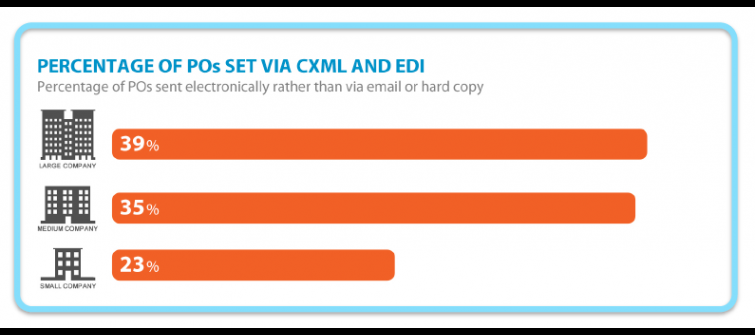Coupa Benchmark: Percentage of POs sent via CXML and EDI

Through Coupa's cloud platform, we track hundreds of metrics to both continually improve our platform and help our customers be successful. The annual Coupa Benchmark is designed to help companies by sharing our data on key finance and procurement performance indicators.
The 2014 Benchmark includes metrics about ten critical areas where we commonly find that companies can easily improve in once they gain insight into what is possible. Today we're focusing on POs transmitted electronically by EDI (Electronic Data Interchange) and cXML (Commerce Extensible Markup Language), rather than via email or hard copy.
Email, while electronic, still requires manual intervention to enter data and move documents through processing systems. EDI and cXML allow for touchless processing. Buyers can transmit POs directly to supplier processing systems and suppliers can send invoices back, directly into buyer processing systems.
Many companies, large and small, are taking advantage of these electronic commerce methods. This metric is offers insight into how widespread that adoption is.
Year over year, our Benchmark shows adoption of these technologies increasing rapidly. Larger companies still lead, but medium and small businesses are closing the gap.
According to our 2014 data, the average large company (over $1.5B in annual revenues) transmits 39 percent of POs electronically, up from 27.5 percent in the 2013 Benchmark. At medium-sized companies ($250M to $1.5B in annual revenues), electronic transmission was 35 percent, up from 22 percent last year.
Small companies (below $250M in annual revenues) still lag, with just 23 percent, but growth has been rapid--last year adoption of cXML and EDI in small companies we studied was just 2 percent.
Faster, More Accurate Processing
Eliminating manual processing and entry of purchase orders reduces processing errors and supports faster turn-around times. Buyers and suppliers both can decrease their transaction time, making for a more streamlined, agile process and saving everyone time and money.
Going Touchless
Begin the transformation by identifying your high-volume PO suppliers. Find out if they support cXML or EDI. For those suppliers that don’t support cXML or EDI today, request that they do. It isn’t expensive to implement and there are many companies that help suppliers set up this capability. The supplier will reap great benefits, as they can reduce manual order processing, reallocate staff, and process orders faster. Plus, they can use electronic ordering across all of their customers.
Small companies cannot match the vast resources of their larger counterparts, so this may be a more difficult request. However, even smaller suppliers have the opportunity to simplify transactions by connecting with buyers via networks like the Coupa Supplier Network, with a minimal investment of time and money. Note: Transactions through the Coupa Supplier Network were not included in this study.
About The Coupa Benchmark
This data was extrapolated from customer usage metrics on the Coupa cloud platform, comprising hundreds of thousands of global users, over 750,000 suppliers, millions of transactions and billions of dollars of spending. The performance metrics are based on aggregate data; no individual companies are identified.
To avoid skew from very small organizations or those that are very new to Coupa, we've only included customers that have accrued a year's worth of spending and at least $5 million in PO spending through Coupa. For reported averages, the extreme outlying data points are eliminated to normalize the data. To learn more click here.